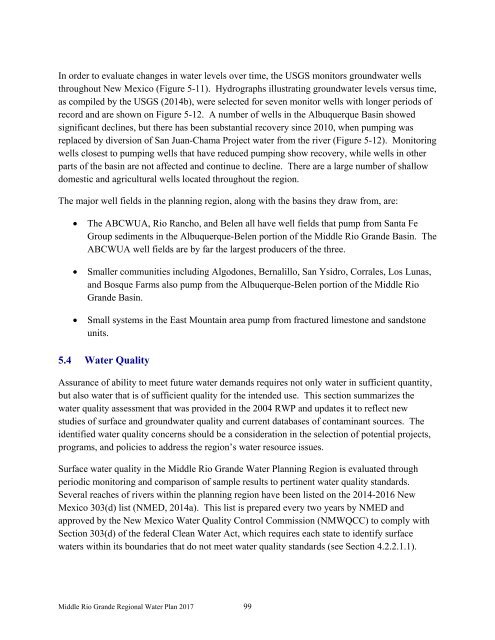Middle Rio Grande Regional Water Plan
2iUWd5b
2iUWd5b
Create successful ePaper yourself
Turn your PDF publications into a flip-book with our unique Google optimized e-Paper software.
In order to evaluate changes in water levels over time, the USGS monitors groundwater wells<br />
throughout New Mexico (Figure 5-11). Hydrographs illustrating groundwater levels versus time,<br />
as compiled by the USGS (2014b), were selected for seven monitor wells with longer periods of<br />
record and are shown on Figure 5-12. A number of wells in the Albuquerque Basin showed<br />
significant declines, but there has been substantial recovery since 2010, when pumping was<br />
replaced by diversion of San Juan-Chama Project water from the river (Figure 5-12). Monitoring<br />
wells closest to pumping wells that have reduced pumping show recovery, while wells in other<br />
parts of the basin are not affected and continue to decline. There are a large number of shallow<br />
domestic and agricultural wells located throughout the region.<br />
The major well fields in the planning region, along with the basins they draw from, are:<br />
• The ABCWUA, <strong>Rio</strong> Rancho, and Belen all have well fields that pump from Santa Fe<br />
Group sediments in the Albuquerque-Belen portion of the <strong>Middle</strong> <strong>Rio</strong> <strong>Grande</strong> Basin. The<br />
ABCWUA well fields are by far the largest producers of the three.<br />
• Smaller communities including Algodones, Bernalillo, San Ysidro, Corrales, Los Lunas,<br />
and Bosque Farms also pump from the Albuquerque-Belen portion of the <strong>Middle</strong> <strong>Rio</strong><br />
<strong>Grande</strong> Basin.<br />
• Small systems in the East Mountain area pump from fractured limestone and sandstone<br />
units.<br />
5.4 <strong>Water</strong> Quality<br />
Assurance of ability to meet future water demands requires not only water in sufficient quantity,<br />
but also water that is of sufficient quality for the intended use. This section summarizes the<br />
water quality assessment that was provided in the 2004 RWP and updates it to reflect new<br />
studies of surface and groundwater quality and current databases of contaminant sources. The<br />
identified water quality concerns should be a consideration in the selection of potential projects,<br />
programs, and policies to address the region’s water resource issues.<br />
Surface water quality in the <strong>Middle</strong> <strong>Rio</strong> <strong>Grande</strong> <strong>Water</strong> <strong>Plan</strong>ning Region is evaluated through<br />
periodic monitoring and comparison of sample results to pertinent water quality standards.<br />
Several reaches of rivers within the planning region have been listed on the 2014-2016 New<br />
Mexico 303(d) list (NMED, 2014a). This list is prepared every two years by NMED and<br />
approved by the New Mexico <strong>Water</strong> Quality Control Commission (NMWQCC) to comply with<br />
Section 303(d) of the federal Clean <strong>Water</strong> Act, which requires each state to identify surface<br />
waters within its boundaries that do not meet water quality standards (see Section 4.2.2.1.1).<br />
<strong>Middle</strong> <strong>Rio</strong> <strong>Grande</strong> <strong>Regional</strong> <strong>Water</strong> <strong>Plan</strong> 2017 99


